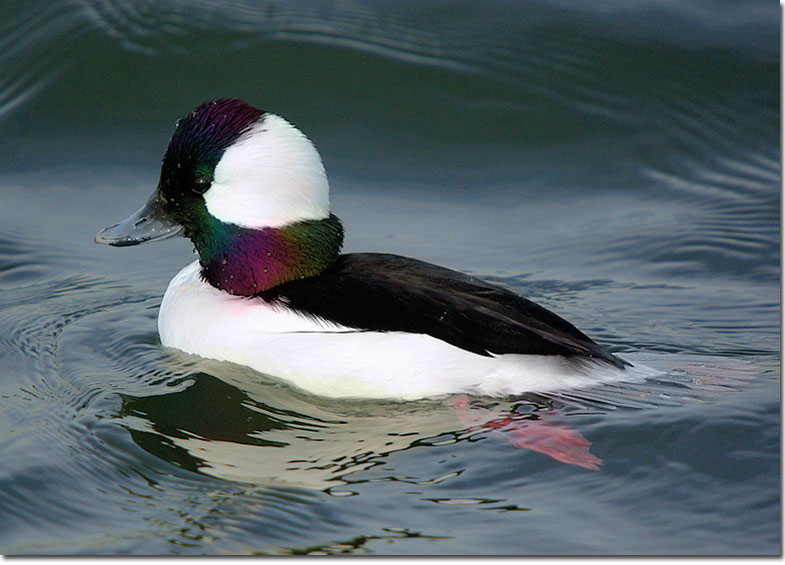Buffleheads (Bucephala albeola), also called butterballs, are easily recognized by the male’s distinctive puffy head shape and black-and-white plumage. This smallest duck species in North America typically dives up to 10 feet underwater for about 12 seconds in search of food.
In this article, you can read all about this interesting bird!
On this page
Breeding Male
Male Buffleheads have crisp white-and-black plumage with iridescent feathers on the black part of their head. Their body is white, their back is black, and their head is black with a large white patch on its backside. The black face feathers shimmer with different shades of iridescence, including green, blue, purple, and bronze, but it can be hard to see.
Their bills are bluish-gray.

Female on left and male. © Greg Lavaty and Alan Wilson.
Female
Female Buffleheads have different shades of black, gray, and white in their plumage that blend together. Their head and upper body are dull black or darker grayish brown whereas their underside is lighter gray. They have a small oval-shaped white patch on their cheeks and dark gray bills.
Juvenile
Buffleheads lay 4-17 cream-colored unmarked eggs in a clutch and incubate them for 28-33 days. Hatchlings are covered in black to dark gray down and have large white cheek patches and a few small white patches on their throats, breasts, and bellies.
The ducklings leave the nest 1-2 days after hatching and are protected by their mother for 3-6 weeks. They find their own food with the mother leading by example. After that, they’re considered independent.
Juvenile and immature Buffleheads look very similar to females.
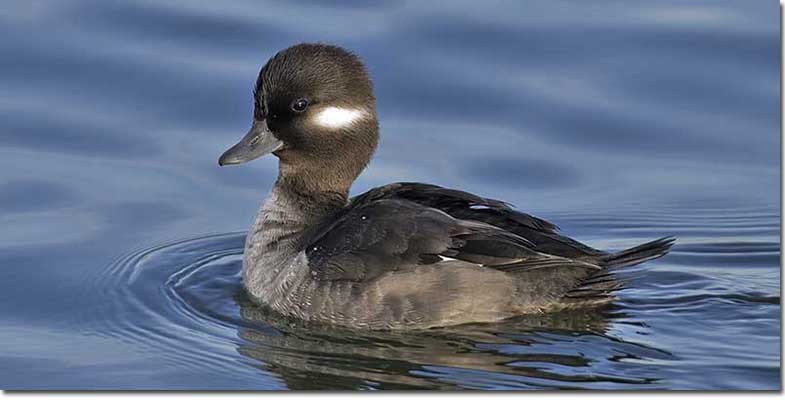
Juvenile Bufflehead
Wing shape
Bufflehead’s wings are short and narrow. Its wingspan is around 21.6 inches. They fly with rapid and stiff wingbeats and rock from side to side. This wing type is capable of offering high speeds and great maneuverability at them, although they can be harder to control at lower speeds. They also use these wings to “fly” underwater.
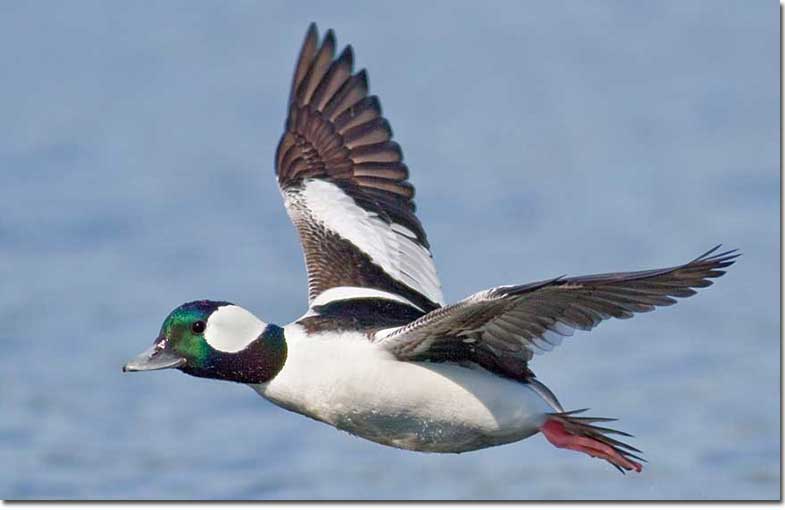
Adult males have a large white stripe on the upper side of their wings whereas females and immatures have a smaller white patch. The bird’s underside is white, and the wings appear grayish. They fly lower when they’re over water but higher over land.
Habitat
Buffleheads’ habitats are always near or right next to water. They breed near ponds, lakes, and rivers that are situated in forests. The birds prefer ponds and small lakes in deciduous and mixed forests, but you may also meet them near rivers or larger lakes and in coniferous forests.
In the winter, they are most often seen near the coast in estuaries, bays, harbors, beaches, and sheltered coves. When migrating, the birds temporarily inhabit any available waterbodies. It is worth noting that they avoid open areas.
See more: 12 Facts About Ducks
Buffleheads are cavity nesters, and they make use of holes dug by other birds, such as woodpeckers and Northern Flickers. They may also use artificial nest boxes. Female lines the nest with down feathers from its chest.
Diet
Buffleheads are primarily carnivores, eating different animal and plant matter found near bodies of water.
The animal part of its diet consists of aquatic invertebrates, fish, crustaceans, mollusks, larvae, large zooplankton, snails, and fish eggs. They also consume plant matter, including seeds, stems, and roots from different aquatic plants, such as bulrushes, pondweeds, and sedges.
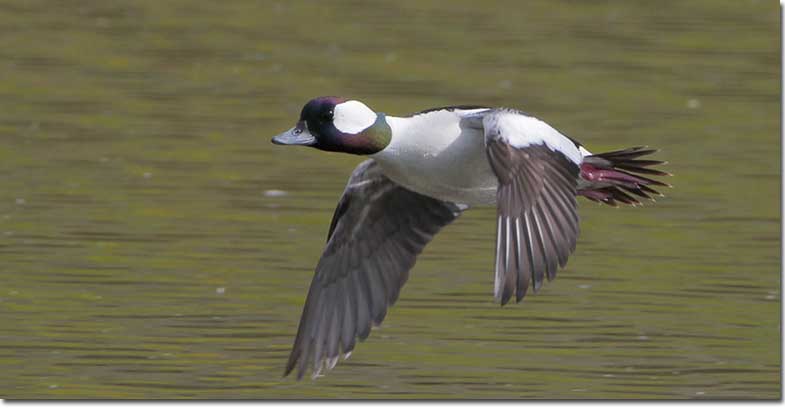
Bufflehead male in flight wings down
Their specific diet varies by season and habitat. In the summer, birds inhabiting freshwater habitats feed mainly on aquatic insects and their larvae, whereas Buffleheads near the ocean consume mainly crustaceans, arthropods, and mollusks. During the fall and winter, they also eat small amounts of plant material and in the winter their main food items are mollusks.
Buffleheads mostly forage underwater and make short and shallow dives. They rarely dabble, except for the young until they grow out of their downy plumage. On average, their dives last for 12 seconds and they rarely dive further than 10 feet underwater. They prefer open and shallow waters for foraging.
Behavior
Buffleheads are active during the day and spend it swimming, feeding, preening, sleeping, and flying. A bit over half of it is spent on foraging and in the winter, they may forage during the night as well. Outside of the breeding season, they form small flocks of 5-10 birds.
During the breeding season, the birds, especially males, are territorial and attack intruders by flying or swimming at them underwater, flapping at them with their wings. When the females have laid the eggs, the males abandon their mate and move to the molting grounds, leaving the female to protect the nest and raise the young. However, they’ll often return to the same female next year.
Buffleheads are prized gamebirds for hunters, making up 1-1.5% of all ducks killed in the United States. They are also useful because they consume pest insects.
Bufflehead range (and seasonal changes)
Buffleheads range throughout North America and into Central America. The birds are mostly migratory. Their breeding range extends throughout most of Canada, from central Alaska to British Columbia and Saskatchewan. Some isolated breeding areas are also in the northern United States.
In late fall, they migrate in small flocks overland, mostly to the east and west coasts of North America and to Central America. You may also see them further inland in the middle of the continent, although that’s less common. A few populations where their breeding and wintering ranges meet are year-round residents.
The Bufflehead population is increasing despite it being one of the most hunted ducks and the threat of habitat degradation. It is listed as of least concern on the IUCN Red List.
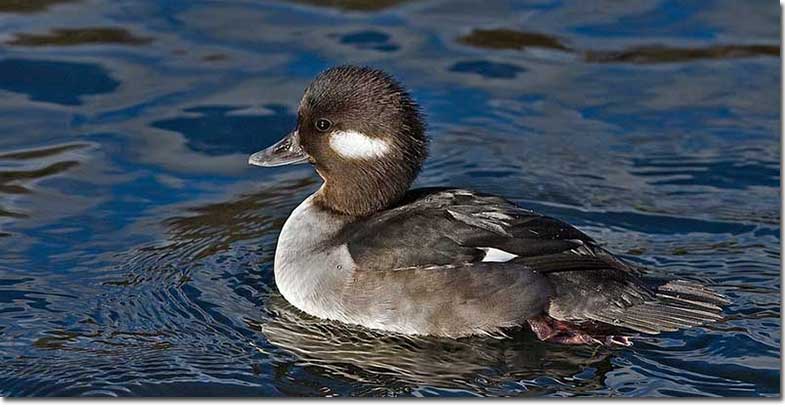
Female Bufflehead side view
Similar Species
Hooded Merganser
Male Hooded Mergansers have a large crest on the head and reddish flanks, and both sexes have thinner bills.
Common Goldeneye
The white on the face of the male Common Goldeneye is in front of the eye, not behind the eye, as is the case with the female Bufflehead.
Fun Facts
- The oldest Bufflehead fossils date back to the late Pleistocene era about 500,000 years ago. The oldest fossil that bears a resemblance to this bird dates back to the late Pliocene, which was around 2 million years ago.
- Buffleheads are the smallest diving ducks in North America. They are able to fly straight up from the surface of the water without having to “run” beforehand.
- Most ducks are not monogamous, but Buffleheads are. Not only will they stay with one female for the breeding season, but they also tend to choose the same one as their mate next year.
- Bufflehead’s average lifespan is 2.5 years. The oldest known Bufflehead was at least 18 years and 8 months old!

Bufflehead group (Female are chasing meale)
Vocalization
Bufflehead’s call is vaguely similar to a crow’s call. Males give a grating chattering call during courtship and squeal and growl during other times. Females give guttural cuk calls that sound similar to a crow’s cawing when surveying nest sites. Mother Buffleheads let out low notes when they want their ducklings to follow her.
FAQ
How rare is a Bufflehead duck?
In the United States, Buffleheads are quite common. However, outside of North America, they’re rather rare and they’re extremely rare in western Europe.
Why is a Bufflehead called a Bufflehead?
Buffleheads got their name from the male’s puffed-up head shape. It’s a direct combination of the words “buffalo” and “head”.
Where are bufflehead ducks found?
Bufflehead ducks are found throughout North America most commonly near ponds and small lakes situated in deciduous and mixed forests but also near rivers and in coniferous forests.
What is the behavior of a Bufflehead?
Buffleheads spend most of their day foraging for food and the remaining time swimming, preening, and sleeping.

